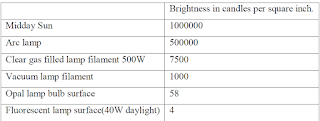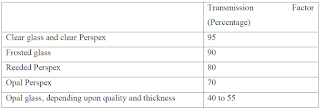How to Reduce Glare in Lighting Installation | Glare is harsh and unwanted light which causes discomfort, nervous strain and fatigue. Perhaps the best example of glare is the blinding effect of a powerful headlight of an automobile coming in front when you are driving on a dark road. It is most annoying and leaves you helpless. It is often the cause of an accident, as you cannot see anything else for a short time. What makes it so bad is because of:
- The bright intensity of the beam itself,
- This beam is focused at the central region of the retina of the eye which is the most sensitive part of it,
- It comes suddenly from a dark background to which the eye is accustomed.
Reduce Glare in Lighting Installation
The remedies adopted should naturally be such as to eliminate the above three causes of glare. Consider first of all the intensity of the light itself. The disparity in the surface brightness of different sources of light is very wide indeed as will be seen from table
|
Brightness in candles per square inch
|
|
|
Midday Sun
|
1000000
|
|
Arc lamp
|
500000
|
|
Clear gas filled lamp filament 500W
|
7500
|
|
Vacuum lamp filament
|
1000
|
|
Opal lamp bulb surface
|
58
|
|
Fluorescent lamp surface(40W daylight)
|
4
|
The levels of the last two sources are low because the light is distributed over a very large surface compared to the surface of the filament. Obviously light sources having low surface brightness should be preferred. If bright source have to be used, glare can be avoided by providing suitable reflectors, enclosing them in diffusing glass globes, by fixing receded Perspex covers or prismatic lenses to diffuse or refract the light and so on. No doubt, there will be some loss of light due to absorption by these devices, but it is more than justified by the increased comfort derived.
The transmission factors given below for different translucent materials give a measure of the percentage of light passed through. Even clear glass absorbs some amount of light.
|
Transmission Factor
(Percentage)
|
|
|
Clear glass and clear Perspex
|
95
|
|
Frosted glass
|
90
|
|
Reeded Perspex
|
80
|
|
Opal Perspex
|
70
|
|
Opal glass, depending upon quality and thickness
|
40 to 55
|
The second remedy is to cover the light source from the field of vision. This is achieved by housing the lamps in properly designed reflectors or providing louvred grills below the lamps. The fittings should also be mounted as high as possible so that no lamp surface may appear below the normal line of sight which is usually taken as 100 above the horizontal plane at eye level of 5 ft. above the ground. A basic idea of good lighting is ‘light to see’ and ‘light to work’ the ideal lighting, therefore, should be from behind or from above, to light up the object to be seen and not in front to strike the face of the person who is to see.
This is so elementary and obvious, yet so often it is disregarded. How irritating it is if someone thoughtlessly hands you when you are sitting in a dark inspection pit, a 100W inspection lamp not fitted with a shield. Your primary concern will then be how to avoid the glare. There is no excuse at all for keeping any hand lamp in a workshop without wire guard and shield.
Coming to the third point, it is useful to know how eye functions. Right in front of the eye is iris diaphragm, which is an involuntary muscle, with a central opening called ‘pupil’ through which light enters the eye. It is focused by a lens, on the sensitive screen behind called the retina and an image is formed on it. The centre of the retina is the most sensitive part of it. The pupil diameter is controlled by the iris automatically by reflex action, depending upon the brightness level of the are under observation.
When the background is dark, the opening is wide admitting maximum light; in daylight it is narrow. Nature has thus endowed man with an automatic protective device which allows him to see effectively and without discomfort over an extremely wide range of illumination levels.
 |
| How to Reduce Glare in Lighting Installation 1.1 |
One peculiarity of the iris is that it acts slowly and cannot respond to sudden changes in brightness levels. You can see in a mirror that pupil contracting slowly if you direct a torchlight beam into the eye in a dark room. It is because of this slow response that you are dazzled by the bright lights of a room when you step in from a dark street, and the night appears much darker than it really is when you step out. Within a short time, however, the eye gets accommodated to the new level of illumination and everything becomes normal.
 |
| How to Reduce Glare in Lighting Installation 1.2 |
Final Word
Hope you understand this article about the How to Reduce Glare in Lighting Installation. Incase of any doubt please comment below. Subscribe our website to get every new post update to your email. Please follow our website @ElectricianWorld.Net for future updates. Thank you for visiting our website.



